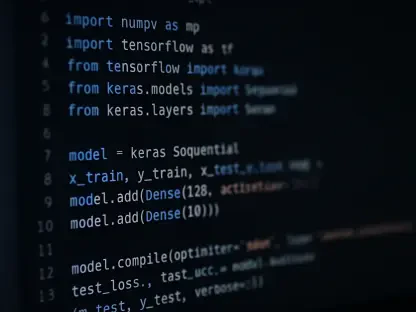The release of nanoVLM by Hugging Face marks a significant stride in making vision-language model development more accessible. Rooted in PyTorch, this framework aims to democratize AI modeling by reducing the complexity traditionally associated with such projects. This innovation opens avenues for a vast audience of developers and researchers, lessening the barriers to engaging with sophisticated AI concepts and applications.
Introduction to nanoVLM
Simplifying AI Model Building
nanoVLM embodies a minimalist framework aimed at simplifying AI model building. It captures the essence of vision-language modeling through just 750 lines of PyTorch code, offering an efficient means for training vision-language models from scratch. This reduction in code complexity does not compromise functionality, providing users with a straightforward entry point into the development of advanced AI models. The project’s approach echoes that of nanoGPT by Andrej Karpathy, which emphasizes clarity and modularity while maintaining practical application relevance. This alignment ensures that even those with limited coding expertise can experiment with and understand AI model construction without the daunting prospect of excess code.
Accessibility for Developers and Researchers
The design of nanoVLM clearly targets both research and educational audiences, emphasizing streamlined complexity to bolster comprehension of critical AI principles. By centering its architecture on simplicity, nanoVLM makes advanced AI modeling techniques accessible to a broader community. This refined approach assists users in overcoming typical barriers associated with learning and employing AI technologies, paving the path for a better grasp of the fundamental aspects necessary for AI implementation. This inclusivity enables developers, educators, and researchers to explore and innovate freely, driving broader community participation and understanding. The framework’s focus on accessibility ultimately democratizes AI, inviting diverse talents and perspectives to the table of AI innovation.
Core Components and Architecture
Modular Multimodal Architecture
At its core, nanoVLM features a modular architecture that integrates three fundamental components: a visual encoder, a language decoder, and a projection mechanism. This configuration provides a foundational platform for image-to-text model experimentation, paving the way for crucial insights in vision-language interactions. The visual encoder, SigLIP-B/16, is a transformer-based architecture adept at extracting pivotal features from visual data, which the language model interprets. On the textual side, the SmolLM2 decoder effectively generates coherent captions, enhancing the user experience in developing vision-language tasks. A straightforward projection layer further ensures alignment between image embeddings and language inputs, maintaining clarity, readability, and modifiability integral for both educational endeavors and agile prototyping.
Vision and Language Integration
nanoVLM’s synergy lies in its seamless integration of vision and language components. Using advanced encoders and innovative decoding mechanisms, the framework translates input images into interpretable language forms. SigLIP-B/16 efficiently handles feature extraction, converting complex images into detailed embeddings suitable for language processing. Meanwhile, SmolLM2, a causal decoder-style transformer, crafts well-structured and contextually accurate captions based on visual prompts. This approach aligns image and text modalities through a projection layer that balances transparency with performance, enhancing the user’s ability to modify and innovate within their AI tasks. Such an arrangement ensures that developers and researchers can rapidly test hypotheses, teaching and learning in environments that prioritize clarity and collaborative exploration.
Performance and Efficiency
Competitive Performance Metrics
Though characterized by minimalist design, nanoVLM demonstrates competitive performance. Trained on a dataset of 1.7 million image-text pairs from the open-source the_cauldron collection, it achieves a commendable 35.3% accuracy on the MMStar benchmark. This level of accuracy positions nanoVLM alongside larger models like SmolVLM-256M, though it notably employs fewer parameters. Such performance suggests that a thoughtful architectural strategy can effectively compete with larger models in vision-language tasks, offering efficiency without sacrificing accuracy. The framework’s balance between computational demands and output performance underscores its suitability for environments striving for computational efficiency, accommodating academic settings with constrained resources or developers operating on single-workstation setups.
Computational Efficiency
nanoVLM proves particularly suitable for resource-limited environments, a crucial feature in academic and research contexts where extensive hardware support might be unavailable. Its efficient use of fewer computational resources enables developers and researchers working within tight constraints to still engage deeply with AI modeling. The pre-trained nanoVLM-222M model, composed of 222 million parameters, exemplifies this balance of scale and performance, suggesting that impactful model design can emerge from a focus on efficient architecture over sheer size. For academic institutions or developers lacking access to expansive GPU clusters, nanoVLM offers a viable pathway to innovation, cultivating a culture of resource-conscious development without compromising model effectiveness.
Transparency and Modularity
Simplified Design
nanoVLM distinguishes itself by adopting a design that is clear and minimally abstracted, placing importance on transparency. Unlike more complex production-level frameworks, nanoVLM is defined clearly within its scope, allowing users to easily trace data flows without facing an intricate web of dependencies. This simplicity is particularly advantageous for educational purposes, facilitating reproducibility in studies and coding workshops. The framework’s transparency helps foster comprehension and empowers users to focus on the practical elements of AI model building without being bogged down by excessive complexity. Such a streamlined approach enhances nanoVLM’s differentiation, providing a unique tool that supports practical learning and innovation.
Extensibility
The modular nature of nanoVLM offers users the flexibility to enhance the framework by integrating more powerful components, such as larger vision encoders or robust decoders. This adaptability encourages exploration into advanced AI topics, including cross-modal retrieval and zero-shot captioning. The framework’s extensibility creates opportunities for users to push boundaries within AI research, adapting and augmenting the model for more sophisticated exercises. By offering this platform for innovation, nanoVLM invites a wider community to engage in meaningful exploration, unveiling new possibilities in AI application and development. This flexibility supports deep learning and collaborative academic research, nurturing a landscape of creativity in model design.
Community Availability and Impact
Open Collaboration
Hugging Face provides the code for nanoVLM and its pre-trained model via GitHub and the Hugging Face Hub, emphasizing openness for community collaboration. This availability encourages user engagement, allowing developers to deploy, fine-tune, and contribute to the framework’s evolution. Hugging Face’s commitment to open collaboration underpins its tools, fostering an inclusive AI community where diverse contributions enhance model efficacy and innovation. This environment nurtures collective growth, inviting educators, researchers, and developers to participate actively in AI’s advancement. By prioritizing open resources, Hugging Face drives broader participation, harnessing community insights to refine models and expanding the impact of nanoVLM beyond its initial scope.
Potential for AI Innovation
Hugging Face’s release of nanoVLM signifies a major leap toward making the development of vision-language models more accessible to a broader audience. Built on the PyTorch framework, nanoVLM is designed to simplify AI modeling by stripping away much of the complexity that has traditionally accompanied these advanced projects. Innovations like nanoVLM serve to democratize AI not merely by offering tools that simplify complex processes but also by empowering developers and researchers who might not otherwise have engaged with such sophisticated AI applications. With this tool at their disposal, individuals across various fields can now venture into AI modeling more freely, broadening the scope for innovation and experimentation. By lessening the technical barriers, Hugging Face is fostering an enriched environment where more people can participate in AI research and development, thereby accelerating progress in the field and expanding the potential for groundbreaking solutions to emerge from a diverse pool of contributors.









